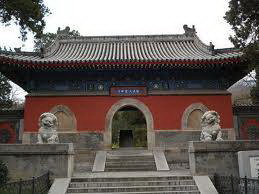In Western Beijing, along the Yangtai Mountains in the Haidian District lies the Buddhist Temple Dajue. Originally built in 1068 under the Liao Dynasty, it was called Quingshui Yuan which literally means Clear Water Temple. This was because a spring of clear water used to flow through the temple. The name Dajue came into existence during the Ming Dynasty. The temple was opened to the public only in 1992 and since then has become a popular retreat for religious, spiritual, cultural and environmentally inclined visitors.
Like most temples that have histories of sun worship, Dajue Temple too is built on an East – West axis. The premises which spans over a 6000 square meter area, consists of a series of halls, courtyard, the bell tower and drum tower as well as other buildings.
The first hall is dedicated to the Future Buddha – Maithriya – and contains a Mathriya Buddha statue and four other statues. Outside the hall is a courtyard that contains a stone pond fed by water flowing through the mouths of several stone animals that date back to almost one thousand years. The second hall is dedicated to Sakyamuni and contains a gilded wooden statue set upon a stone alter together with various tablet inscriptions by Emperors and other leaders. The Hall of Amitabha is next and contains a Buddha and two other statues. Apart from the buildings, the Dajue Temple is also famous for its ancient trees numbering to around 160, including the Ginkgo Trees and Magnolia trees – one of which is thought to be over 900 years old. Visitors throng to the temple during April a time when the Magnolia tree blossoms and the Magnolia Festival are usually held.
A pagoda with the remains of a monk, halls of worship, peaceful courtyards, small temples and shrines make up the rest of the Dajue Temple’s premises. It is the ideal location for some reflection as you pass through China.
If you are visiting and are looking for Apartments in Beijing, then rather than an impersonal hotel option visitors may be pleased with Serviced Residences. An Apartment Beijing offers proportionate spaces and plenty of room to relax, enjoy as well as conduct business if needs be. Luxury Serviced Residence Beijing houses some of the finest serviced apartments in the city and will make for a truly memorable stay
Like most temples that have histories of sun worship, Dajue Temple too is built on an East – West axis. The premises which spans over a 6000 square meter area, consists of a series of halls, courtyard, the bell tower and drum tower as well as other buildings.
The first hall is dedicated to the Future Buddha – Maithriya – and contains a Mathriya Buddha statue and four other statues. Outside the hall is a courtyard that contains a stone pond fed by water flowing through the mouths of several stone animals that date back to almost one thousand years. The second hall is dedicated to Sakyamuni and contains a gilded wooden statue set upon a stone alter together with various tablet inscriptions by Emperors and other leaders. The Hall of Amitabha is next and contains a Buddha and two other statues. Apart from the buildings, the Dajue Temple is also famous for its ancient trees numbering to around 160, including the Ginkgo Trees and Magnolia trees – one of which is thought to be over 900 years old. Visitors throng to the temple during April a time when the Magnolia tree blossoms and the Magnolia Festival are usually held.
A pagoda with the remains of a monk, halls of worship, peaceful courtyards, small temples and shrines make up the rest of the Dajue Temple’s premises. It is the ideal location for some reflection as you pass through China.
If you are visiting and are looking for Apartments in Beijing, then rather than an impersonal hotel option visitors may be pleased with Serviced Residences. An Apartment Beijing offers proportionate spaces and plenty of room to relax, enjoy as well as conduct business if needs be. Luxury Serviced Residence Beijing houses some of the finest serviced apartments in the city and will make for a truly memorable stay










